 Guru Nanak, the first Sikh Guru lived a pious life of a householder, yet he embraced spiritualism. As a young man herding the family cattle, Guru Nanak would spend long hours absorbed in meditation or in religious discussions with Muslim and Hindu holy men who lived in the forests surrounding his village.
Guru Nanak, the first Sikh Guru lived a pious life of a householder, yet he embraced spiritualism. As a young man herding the family cattle, Guru Nanak would spend long hours absorbed in meditation or in religious discussions with Muslim and Hindu holy men who lived in the forests surrounding his village.
Guru Nanak associated with people from all walks of life. Pundits, mullahs, and scholars schooled Guru Nanak while he learned Sanskrit, Persian, and Arabic by reading the Vedas, various scriptures, and Koran. Guru Nanak was joined by his Muslim childhood friend Mardana, and they would meditate and sing hymns together.
Early one morning, Guru Nanak went to a nearby forest and disappeared for three days of intensive meditation. After returning he was no longer the same person he had been and his first spoken words were, “There is no Hindu, no Muslim, we are all children of one God.”
From an early age Guru Nanak showed a deeply spiritual character. He broke away from his family’s traditions and belief systems, choosing to not participate in empty rituals. His father arranged the Hindu thread tying ceremony symbolizing man’s connection with God. Nanak refused, objecting that the thread had no value because it would eventually wear out.
He traveled extensively to religious centers in India and abroad with Mardana to spread the message of a spiritual God who is not judgmental and does not demand compliance with meaningless rituals. He spoke out against the caste system, teaching instead the equality of all humanity.
Nanak traveled to Mecca. While he lay there resting, the mullahs told him to be careful not to point his feet toward Kaaba while he slept. As the story goes, Nanak replied that they should turn his feet where God was not, and it is said, the holy stone of Mecca turned toward wherever they turned his feet. The symbolism means only this—wherever you turn your feet, there God is. Where will you put your feet if he is omnipresent?
On his return journey home, he stopped at Saidpur in western Punjab during the invasion of the first Mughal Emperor Babur. Guru Nanak and Mardana were both taken prisoner by the Mughals along with their group of disciples and Saidpur inhabitants.
While in jail Guru Nanak sang divine hymns about the senseless slaughter of the innocents by the Mughal invaders. Upon hearing it the jailer reported it to his king.
Babur sent for Baba Nanak and interrogated him.
“Do you believe in God?”
Nanak shared the Mool Mantra, his definition of God with Babur, “There is but one God, his name is truth, he is the creator, he fears none, he is without hate, he never dies, he is beyond the cycle of births and death, he is self-illuminated, he is realized by the kindness of the true Guru.”
Surprised at the simple yet powerful message, Babur asked Nanak if he had performed his Haj?
Nanak explained that he had performed his Haj pilgrimage accompanied by Mardana a Muslim disciple. He traveled with Hindus and Muslims without any distinction.
Babur grasped that Baba Nanak was not a kafir requiring conversion but a Spiritual Baba who believes in God, performed his Haj duties, has Muslim devotees, believes we are children of the same God and offered to free Baba Nanak immediately.
Nanak replied, “I have already forgiven you but it is the forgiveness of Allah that you should seek. The only way for you to show true repentance is by releasing all the inhabitants of Saidpur and restoring their property to them.”
Realizing that Baba Nanak and his disciples were not a threat to his rule, he ordered release of the prisoners. Mool Mantra’s spiritual message had saved Baba Nanak and his disciples from the prisons of Babur.
Nanak shared his spiritual message everywhere he traveled; spreading positivity and teaching equality with the message of one universal God.
